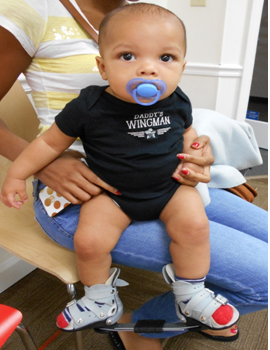
Clubfoot Treatment
What is clubfoot?
Clubfoot is a congenital deformity of the foot. It results from the abnormal development of the muscles, tendons, and bones in the foot while the fetus is forming during pregnancy. The incidence rate for children born with clubfoot is 1 in 1000. This is the most common birth defect to need intensive orthopedic treatment.
What is the Difference Between Postural Clubfoot and Congenital Clubfoot?
Postural Clubfoot: In rare cases, clubfoot is just the result of the position of the baby while it is developing in the mother’s womb (postural clubfoot). With light manipulation and casting this is easily corrected.
Congenital Clubfoot: This is a true birth defect, and is more common than postural clubfoot. Although clubfoot is recognizable at birth, the severity of the deformity can vary from mild to an extremely rigid foot that is resistant to manipulation. The collagen of the lower leg and foot are abnormal and this makes congenital clubfoot more difficult to treat.
How is Clubfoot Corrected?
Clubfoot in an otherwise normal child can be corrected using the Ponseti Method of manipulation and plaster cast applications. Ponseti Method Treatment should begin in the first week or two of life in order to take advantage of the elasticity of the tissues that form the ligaments and tendons in the foot. A small surgical incision is almost always required at the back of the heel. After cast treatment, patients are placed in special orthopedic shoes held together with a “Dobb’s Bar”.
How Long will the Child Need to Wear the Dobb’s Bar and Shoes?
When the last cast has been removed the shoes and bar are applied. The child wears them full time (except for one hour per day) for 3 months. They then switch to only nighttime wear of the shoes and bar until the child is 3-5 years of age.
What if My Child Doesn’t Like or Kicks Off His/her Shoes?
Parents have a very important role once the child is put in shoes with the bar. After the first day or two, infants become accustomed to the shoes and play as normal. Parents may also teach the child to move his or her legs at the same time, making it easier for the child to learn to move about. If parents are not vigilant and strict about keeping the shoes on, the feet might relapse. If parents have continued difficulty keeping the shoes on, they must visit the orthotist for modification.
What is the Future Like for a Child who has Clubfoot?
Babies treated using the Ponseti Method will have normal looking feet, with good mobility and function throughout life. The long term outcomes from this method have far exceeded those of surgical treatments. Follow-up studies of clubfoot patients show that children and adults with corrected clubfoot may participate in athletics like anyone else.
“6 month old POBAR patient undergoing successful clubfoot treatment”
Helpful Tips for Wearing the Brace:
Expect your child to fuss for the first couple of days when in the brace. This is not because the brace is hurting him/her, but because it is something new and different.
Play with your child in the brace to help him/her get used to not being able to move his/her legs independently.
Gently push/pull on the bar of the brace to teach your child to flex and extend his/her knees.
If you notice any red spots or blisters on your child’s feet, call the orthotist to see if modification is necessary.
Frequent Questions:
What happens if the clubfoot deformity is not corrected?
If the clubfoot deformity is not corrected your child will develop an abnormal gait. The limp is severe. Because the child will walk on the outside and top of the foot the skin will break down. This can leave your child susceptible to infections. Also, walking on the outside of the foot can lead to joint problems. A link below shows a video of a grownup whose clubfeet were not treated.
Does the manipulation hurt?
Manipulation in the cast is gentle and does not cause any pain.
Why is the cast placed above the knee?
Sometimes babies pull a Houdini on us and wiggle out of their casts. One of the reasons we place the cast above their knee is to prevent this. If your child does slip out of her cast, please call us right away for a new one. If she is out of her cast for a day or two, the treatment will probably take one or two more weeks.

Follow Us On Instagram!
Contact us.
If you have any questions or concerns about the services we offer, do not hesitate to reach out by phone or email and a member from our team will follow up with you right away!
appointmentrequests@pobar.org
(813) 548-5056
602 Vonderburg Dr #103, Brandon, FL 33511
This function is used for appointment requests. Unless you’re contacted by the office, your appointment is not confirmed.






















